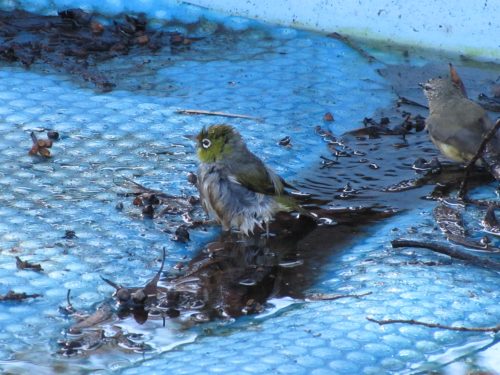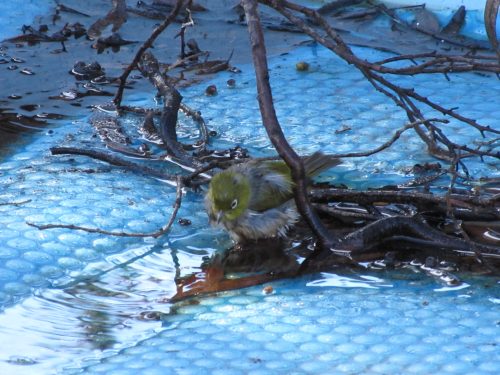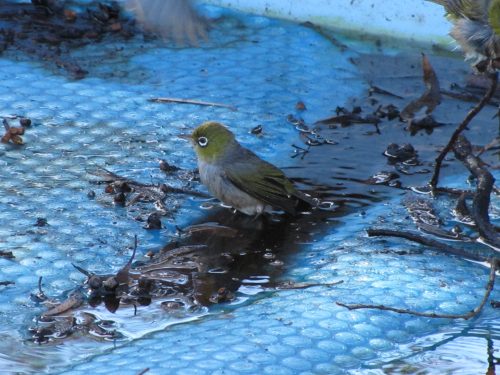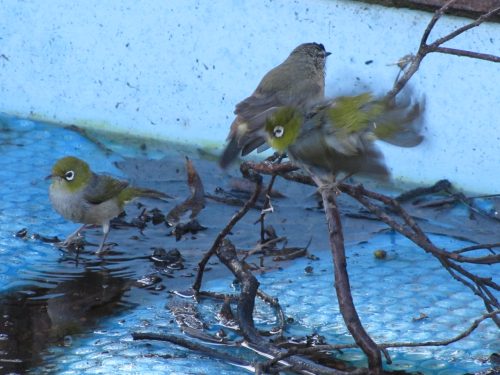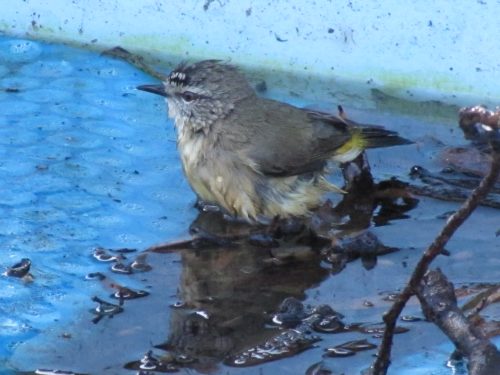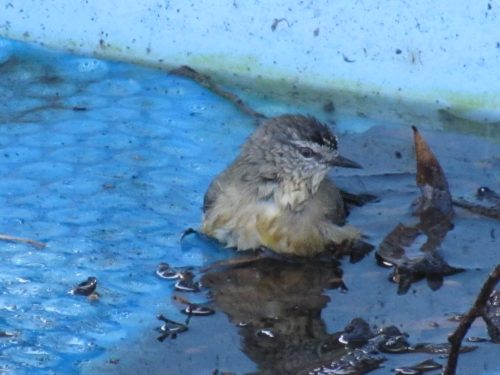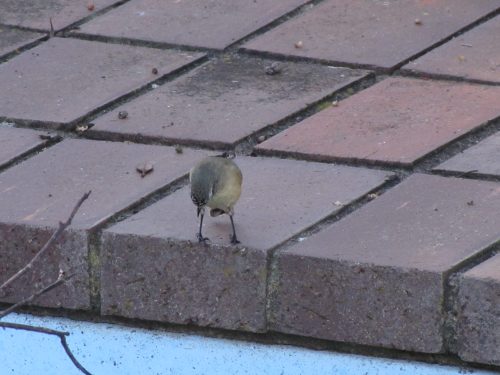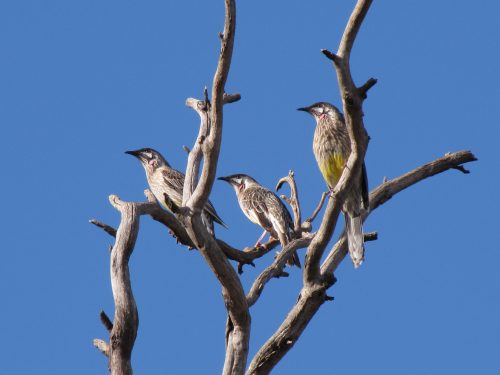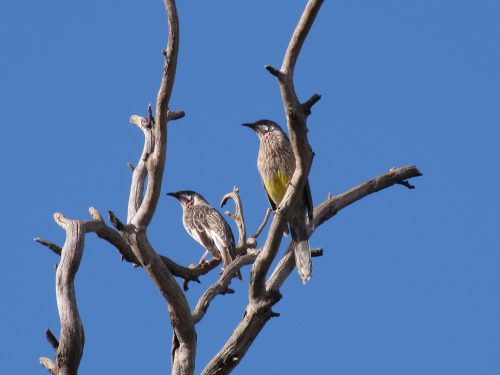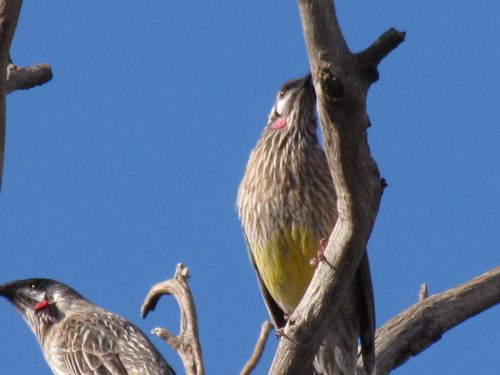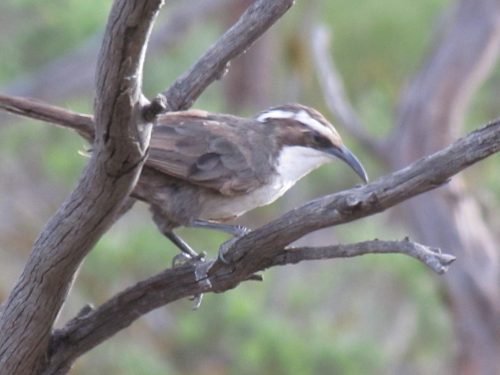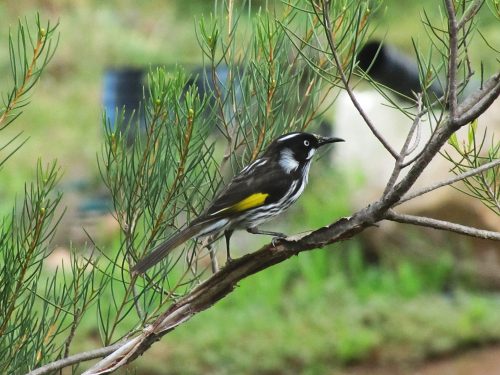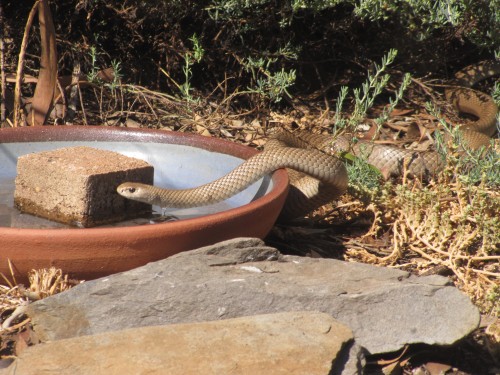Silvereyes come for a bath
In my last article here I posted some photos of Yellow-rumped Thornbills bathing in the small pools of water which gather after rain on our swimming pool solar blanket. On the same day, a small number of Silvereyes also came for a drink and to bathe. I have shown these in today’s post.
Our swimming pool is in our backyard, a short distance from our back veranda. On nice sunny days when it is not too hot in the middle of summer, or not too cold in the middle of winter, we enjoy sitting on the veranda to have our lunch. Sometimes we take a mid-morning break there for a cup of tea or coffee. We have also taken an afternoon break when gardening.
On all of these occasions, we enjoy the constant parade of birds in our garden, perched on the fence or in the trees nearby, and on the pool cover like the Silvereyes shown today. I often have my binoculars and camera at the ready while we sit there. On this occasion, I managed to get many photos of the Silvereyes and the Yellow-rumped Thornbills. A Grey Fantail was also fluttering around, but you will have to return in a few days’ time to see those photos in my next post.
The water that gathers on our swimming pool cover in the winter and spring months are visited by many birds over the course of each day. In addition to the species I have already mentioned, another frequent visitor is the Magpie Lark. Both the male and the female come on a daily basis, often perching on the pool safety fence and calling loudly, their antiphonal singing a delight to hear. (Antiphonal: when the two birds sing a duet in parts.)
Our resident Australian White-backed Magpies also come to drink, and the bossy Red Wattlebirds will chase the smaller birds off. White-plumed Honeyeaters flit in and out nervously, while the Peaceful Doves take their time, gradually getting closer and closer until they gather the courage to stoop and drink. The Crested Pigeons also come for a drink, though they are usually more interested in mating displays than drinking.
The Welcome Swallows occasionally swoop low over the pool but more often they are seen much higher in the air. The many House Sparrows and Common Starlings come frequently to drink and bathe, but the resident Mallee Ringnecks rarely do so; they prefer to feed in the nearby trees. The Willie Wagtails, however, are frequent visitors to this part of the garden.
As you can see, it is never boring in our garden if you are a birder like myself.
Good birding,
Trevor
PS: Over the years, I have written articles about all of the birds mentioned in this article. To see photos of them, and to read more about each of them, use the search facility in the top right-hand corner of any page.
Thornbills come for a swim
In our garden, we have a swimming pool. At the moment, it is more of a swamp. It will need a LOT of cleaning before the warm summer days come blowing in from the north over the coming months. We enjoy our pool on those hot, summer nights because it is so relaxing. And the exercise is good for us, too. (When we have the energy!)
We also have a solar blanket on the pool. This has a number of purposes:
- It warms the temperature of the water so that we can enjoy an extended swimming season, even in the cooler months.
- It reduces the need for chemical treatment to keep the water safe for swimming.
- It reduces evaporation; our water prices in South Australia are some of the highest in the world and the blanket minimises the amount of topping up the pool needs, thus saving money.
- It keeps things like leaves from nearby trees out of the water which saves me time and effort cleaning the pool.
With the solar blanket on during the winter, the rain we have had tends to gather on the surface in pools. Many of our resident bird species take advantage of this fact. They come to either drink or to bathe in the water. Recently, a small flock of Yellow-rumped Thornbills did just that. they had a glorious time splashing around in the water. They totally ignore the nearby bird baths. Why use a bird bath when you can bathe in your own swimming pool?
Good birding,
Trevor
Further reading:
I was swooped by a wattlebird
On our trip to Sydney last week, we stopped for a brief rest at the Wagga Wagga Botanic Gardens. This is one of our favourite stopping places on our way from home in Murray Bridge, South Australia, when we are going to Sydney to visit family. On this occasion, we stopped there to have morning tea, and to change drivers.
The botanic gardens in Wagga Wagga have a good representative range of both Australian and exotic plants. The gardens are beautifully set out with plenty of areas of lawn for visitors to have picnics. The good range of plants means that visitors can see something flowering at most times of the year. This also means that there is also a good range of birds present in the gardens and the surrounding environment no matter when one visits.
On this occasion, we were somewhat pressed for time, so I only had the chance to make a small list of the birds I saw. I didn’t even get my camera out, so the photos in today’s post were taken a few weeks ago near our home. I was in the middle of having a cup of tea and looking around at the flowering Grevilleas and Callistomens in the Australian Native Garden section.
I saw a Red Wattlebird land in the bush next to me. I thought it was about to feed on the many flowers in this bush. Instead, as it perched there, it screeched at me – as if it was growling at me. It flew off briefly, returning very low over my head and clacking its beak as it again flew into the bush. It repeated this action several times, each time swooping low over my head. It seemed to be irritated by my presence.
Its next action revealed its true intention. A small crumb from my piece of cake fell to the ground. Immediately, the Wattlebird swooped down and picked it up. It was obviously calling to me to feed it some cake. I guess many visitors do feed the birds during their picnics. In Australia, this is discouraged because many forms of human food are actually harmful to our birds. There is no reason to feed our birds because they have access to a wide range of natural foods.
The most interesting thing about this close encounter was that this individual had learned to swoop humans in order to get food handed to it. I have been swooped by Wattlebirds before, but it is a fairly rare occurrence in my experience.
Good birding,
Trevor
Further reading:
- The problem of swooping magpies
- Do Blackbirds swoop? Dealing with aggressive birds.
- Pesky Plovers – dealing with swooping birds
Babblers building a nest
The White-browed Babbler is a common bird species around where I live in Murray Bridge, South Australia. They could almost be considered as a resident species in our garden and on our five-acre block of land, but we don’t see them every day. Frequently – but not every day. Their range must be larger than just our property.
A few days ago my wife and I had been out for the morning. I drove down the driveway and we stopped in the car for a few minutes to enjoy the warmth of the sunshine. It was a cold, blustery day with occasional showers. As we sat there chatting, we noticed a White-browed Babbler hopping along the driveway in front of the car. It had a few small twigs in its beak and was pecking at the ground, collecting more twigs. As it flew towards us, it looked like it had whiskers sticking out from its beak.
The bird flew immediately into the Grevillia bush next to the car. We immediately realised that it had been carrying nesting material. After a minute or so, we saw it fly out of the bush to another spot in the garden where it started collecting more twigs. While it was gone, I went to the bush and easily found the partly made nest. I did not linger long because the nesting building bird was on its way back to the nest.
Over the next few days, the Babblers in our garden busily kept working on the nest. I had another peek into the bush the day before we left on our four week trip to Sydney. The nest then looked complete, but I did not want to hang around too long to check whether any eggs had been deposited in the nest. If there are eggs in there, they will probably hatch out before we return home. We may be just in time to see the new hatchlings when we return.
Further reading:
- White-browed Babblers
- White-browed Babblers and water
- White-browed Babblers – one of my earlier posts written over 10 years ago.
Upset New Holland Honeyeaters
Last week my wife and I were sitting on our back veranda having lunch. We were enjoying a brief burst of spring weather and the sun was most welcome. We have had a long stretch of very cold, showery, wintery weather for well over a month, so the change was very much appreciated.
I often have my binoculars at the ready in case I want to check out any of the many birds we see in our garden. Sometimes I even have my camera at the ready, too. As we were enjoying a cup of tea after lunch, a flock of about a dozen New Holland Honeyeaters set up a terrible racket in the bushes about ten metres from where we were sitting. I immediately thought that their warning calls meant that there was a bird of prey in the sky overhead, or else it was in the trees nearby.
On looking around, and checking the sky, I could not see any evidence of anything they could be getting upset over. All of the honeyeaters kept calling and fluttering around, obviously quite agitated by something on the ground. I cautiously walked towards them. They took no notice of my presence and kept calling loudly.
Snake!
A metre long Eastern Brown Snake was trying to stay inconspicuous in the shadows, but I caught a glimpse of it as it made its escape into the undergrowth – and away from the keen eyes of the resident honeyeaters. I slowly made my retreat, intent on not getting too close to one of the world’s deadliest reptiles right there in our garden.
Every summer we usually see one or two Brown Snakes in our garden, on our five-acre property, or crossing the road leading to our home. We usually give them a wide berth when we see one and never try to get too close. They don’t bother us and we don’t bother them. I prefer to let them be because not only are they protected under our laws, they also do us the service of keeping mice and rat numbers down to a manageable level. My only concern was that this was rather early in spring for our first sighting; summer won’t start until December.
I guess that we will have to keep an eye out for them in the coming months. Proceed with caution.
Further reading:
- Bird baths are not just for birds – this post includes photos of a Brown Snake at one of our bird baths,
- Brown Snakes and Woodswallows
- Beautiful birds, leaping lizards and slithering snakes
